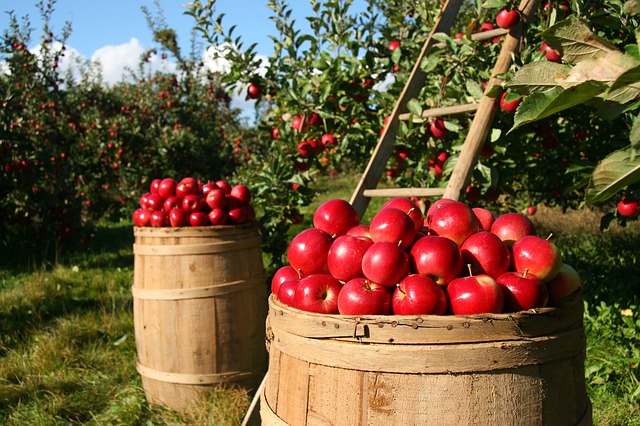Taking good care of your fruit trees in the winter is essential to their survival of the winter, and helps get rid of all those bad news bugs, fungal spores, and bacteria. Here are the steps you can take ensure your trees stay healthy, happy, and pest-free.
1. Start winter preparation right by cleaning up in the orchard in the fall. Make sure any leftover fruit is disposed of, rather than being left to ferment on the ground. Rotting fruit is just the sort of thing that attracts the bugs and other bad stuff you want to keep far away from your trees. Also, make sure to take any dead fruit off of your trees. Once the leaves are gone, check your trees over for any signs of disease or damage. You want to be on the lookout for cracks and abnormal coloration and growths. If you find anything like this be sure to remove or treat it right away. Be sure also to remove any dead fruit from the tree. After the leaves have fallen, give your fruit trees a thorough inspection for signs of disease or damage. Look for any cracks, discolorations, unusual growths or other signs of damage. Remove or treat any wood that shows signs of damage or disease.
2. Prune your dormant trees between December to February. Eradicating weak branches helps to keep away bugs and bacteria. Remove dying and diseased branches as well as root suckers, branches that are crowding each other, and branches growing straight out. Sterilize your shears beforehand either with rubbing alcohol or tea tree oil.
3. Guard against animal invaders. If you have a busy wildlife presence in your area, you also may need to protect your fruit trees from deer, rabbits, mice and other animals that are looking for an easy wintertime meal.
“The Big Book Of Off The Grid Secrets” — Every Homesteader Needs One!
For trees less than 5-7 years old, use tree wraps or wire mesh to protect trunks from mice and voles, making sure they are partially buried. Though nothing short of an 8-foot fence is guaranteed to keep deer at bay, a barrier of poultry netting or woven wire can help protect your trees. Scent repellants also may work, including liquid repellents like coyote urine or hanging a highly scented bath soap from the tree’s branches.
6 Ways To Ensure Your Fruit Trees Survive The Winter
Image source: Pixabay.com4. Wash the trees. The dormant season is prime time to “wash” fruit trees. Washing, or spraying, is the most successful way to kill off any bacteria, fungal spores, insects or insect larvae that may be hiding in your tree. Spraying should only be done in the winter when trees are deeply dormant, before any new buds have begun to show. Dormant oil sprays are available online or in most gardening and home improvement stores. These usually contain some type copper and/or lime, fish oil, or plant-based oil and can be found in organic forms, as well. Do your spraying when temperatures will be consistently above freezing for a few days. Make sure to wet all surfaces thoroughly, especially bark fissures. Since these sprays work as a contact insecticide, getting into all the nooks and crannies — especially around the base of the trunk — they ensure that you will kill off all of those hidden aphids, mites and other harmful bugs.
5. Protect your trees from sunscald before the cold arrives. Sunscald is the result of bark heating up during the day and then freezing again at night. Sunscald can leave your trees with open scars, making them more susceptible to insects and disease. To ensure this doesn’t happen you can wrap your younger trees with commercial tree wrap. Applying a 1:1 solution of water and white latex paint to mature trees proves effective as well.
6. Keep the roots insulated. This is arguably the most important thing you can do to keep your trees healthy over the winter. Your best bet is using a thick layer (think 4-6 inches for young trees) of mulch. You have lots of options when it comes down to what kind of mulch to use: bark mulch, pine straw, leaves, wood chips, straw, even snow. Cover your mulch with a black trash bag or black landscape fabric for an extra layer of protection.
Yes, it’s a bit of extra work, but add these steps to your winter caretaking routine and your trees will thank you. You can put your feet up in the evening with the knowledge that healthy, happy summertime trees are just around the corner. Winter doesn’t last forever, you know.
Check out offthegridnews to learn more about the steps you can take to successfully winter your fruit trees.
